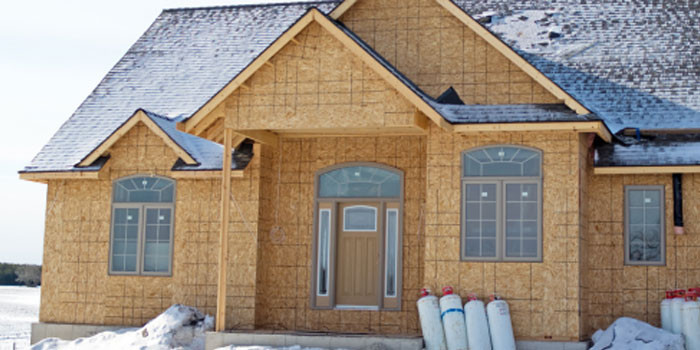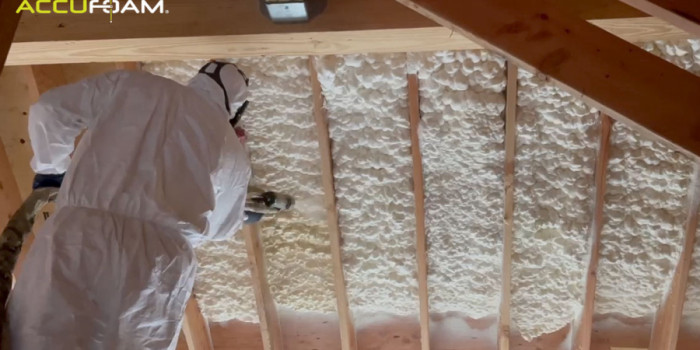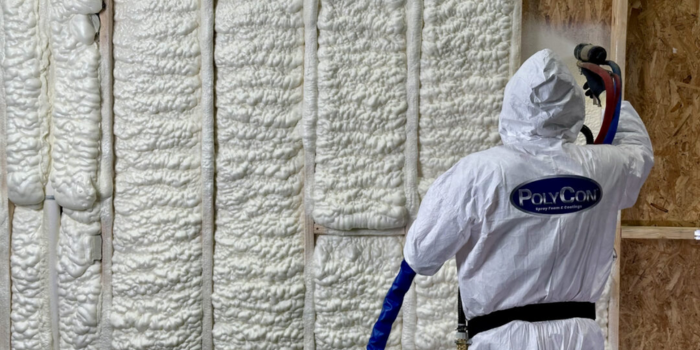Lifespan


SPRAY FOAM MAGAZINE – Until recently, decarbonizing the building sector has focused mainly on operational carbon, which reduces the energy demand of existing and new construction. However, it is also essential to analyze the carbon emissions achieved by designing high-performance buildings and the influence of carbon in all the materials and components required to construct them.
Rocky Boyer is the Building Science and Sustainability Manager at Elastochem Specialty Chemicals Inc. He has over 20 years of experience in sustainable building design, a degree in architecture, a master’s in building science and regularly collaborates with architects and designers. Therefore, he is a great choice as the insulation subject matter expert on a research project, named New Design Resources for Embodied Carbon Targets, conducted by RDH Building Science Inc. and Toronto Metropolitan University.
“Buildings undergo stages over their lifespan, from design, construction, operation, and retrofits. At the initial stage of designing a building, and in addition to focusing on operational carbon, choosing construction materials that have less embodied carbon is fundamental,” explained Rocky.
Embodied carbon emissions related to building enclosure systems contribute impactfully to the emissions over a building’s lifespan. The research aimed to show the embodied carbon emissions from building enclosures by analyzing 26 commonly used enclosure systems. This study will help provide tools for design teams to start to consider and address these issues.
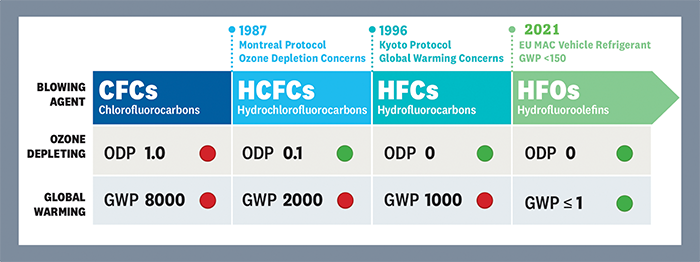
FIGURE 1: Evolution of Blowing Agents
Provided by ElastochemThe Canadian government is dedicated to achieving net-zero emissions by 2050 under the Canadian Net-Zero Emissions Accountability Act. This global context is also helping push change in building codes and regulations throughout North America.
SPF is recognized for its sustainability benefits that go beyond energy efficiency. The carbon reduction through its manufacturing and transportation, in addition to other materials installed at insulation, can result in a noteworthy reduction. As an insulation, its carbon reduction is achieved through energy efficiency, manufacturing, resiliency, transportation, and installation.
It is crucial to educate architects on this subject as they are primarily the ones driving sustainable design in buildings. If they neglect to explain the effects of sustainable design to their clients and the proposed outcomes are not properly documented, unproven designs and materials may be trusted and could be in non-compliance with government regulations.
How is spf helping lower the carbon footprint?
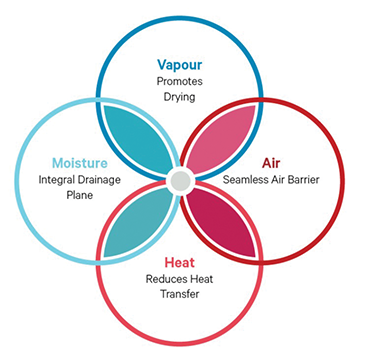
FIGURE 2: Spray Foam Control Layer
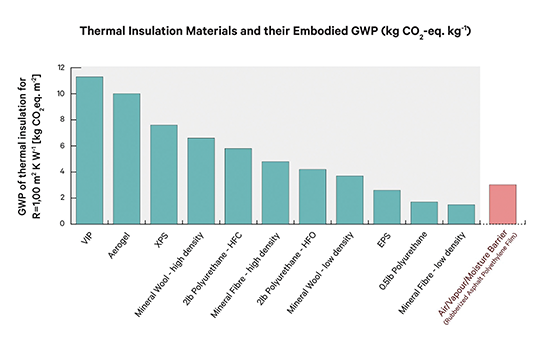
FIGURE 3: Thermal Insulation Materials and their Embodied GWP (kg CO 2 -eq. kg -1
Manufacturing Spray Foam
There are two types of insulation facilities. The first is a blending facility, and the kind used for SPF, where the blending of the raw chemicals takes place and then shipped and manufactured on-site. The traditional stationary manufacturing plant is where the product is made and shipped to the job site where it can be installed. In addition, recycled materials like plastic can be used as a raw material in production. As an example, Elastochem uses 3000 post-consumer PET bottles in one set of spray foam; diverting over 200 million plastic bottles from the landfill each year.
Evolution of SPF
The “first generation” of refrigerants/propellants included highly toxic chemicals like ammonia and sulfur dioxide. The “second generation,” called chlorofluorocarbons (CFCs), was created without these harsh chemicals. The “third generation” hydrochlorofluorocarbons (HFCs) replaced chemicals that damaged the ozone layer. However, their global warming potential was high so the “fourth generation” hydrofluoroolefins (HFOs) were created. These refrigerants/propellants not only stop the negative impact on the ozone layer but also lower the impact of global warming.
Spray Foam Control Layers
Many insulations on the market today have one to two control layers within an enclosure. Spray foam insulation can be used for three to four control layers including:
- Water control layer
- Air control layer
- Thermal control layer
- Vapor control layer*
These layers have the potential to reduce the additional need for membranes, many of which are bitumen-based. Bitumen requires energy-intensive extraction and processing methods, resulting in the release of carbon dioxide, methane, and other greenhouse gases into the atmosphere, and therefore has a significant impact on the environment.
Transportation
Transportation of materials from the manufacturer to a project site or distribution center has a large impact on the embodied carbon due to the limited amounts of insulation manufacturers around North America. Traditional insulation such as Mineral Wool Boards or Board Foam (XPS/EPS/Polyisocyanurate) manufacture the boards in a stationary facility and ship the product to its specified location, SPF manufacturers ship their raw materials to its specified location. When spray foam applicators manufacture their material on-site, they mix the two liquids together and the insulation expands to 60-120 times its liquid size. With this expansion of SPF being so high, more board feet of insulation can be shipped compared to traditional board stock insulation. An example of this is one truck load of 2lb ccSPF is equivalent to five truckloads of board stock insulation, one truck load of 1lb ocSPF is equivalent to nine truckloads of board stock insulation, and one truckload of 0.5lb ocSPF is equivalent to 18 truckloads of board stock insulation. Reducing tractor trailers on our highways will reduce the overall impact from transportation, wear and tear on the trucks (maintenance), and traffic congestion.
Severe Weather
Closed-cell foam is the only insulation classified as acceptable by FEMA for use in floors, walls, and ceilings. It can also be kept in place following flooding unless damage has happened behind the insulation. It is considered a flood-resistant product, and according to the Federal Emergency Management Agency (FEMA), flood-resistant refers to a material that will not sustain significant damage after 72 hours of contact with flood waters. Consequently, SPF is both durable and has an extended lifespan, resulting in less material in landfills.
Spray Foam End of Life Uses
SPF can endure significant variations in moisture buildup and extreme temperature fluctuations. With an estimated lifespan of 80 years, if installed correctly and is in an enclosed build. There are three possible uses for SPF at the end of life.
Mechanical recycling/adhesive pressing – Where the foam is broken down and made into another product.
Glycolysis/chemical recycling – Where the foam is broken down to form new polyols.
Energy Recovery – This involves burning the foam which creates energy and using that energy elsewhere.
Insulation is routinely measured by R-value, but many factors must be considered when deciding on sustainable insulation. A global view of materials with their “birth” to “death” cycle must be studied and calculated to have a complete understanding of their environmental impact. Resulting in architectural design aiming to minimize damage to the environment and ecological systems, along with human health, will also have a greater understanding of an insulation’s lifespan and make an informed decision.
* specific to open-cell
Spray Foam Magazine does not take editorial positions on particular issues; individual contributions to the magazine express the opinions of discrete authors unless explicitly labeled or otherwise stated. The inclusion of a particular piece in the magazine does not mean that individual staff members or editors concur with the editorial positions represented therein.
For use by SprayFoamMagazine.com & Spray Foam Magazine
Disqus website name not provided.






